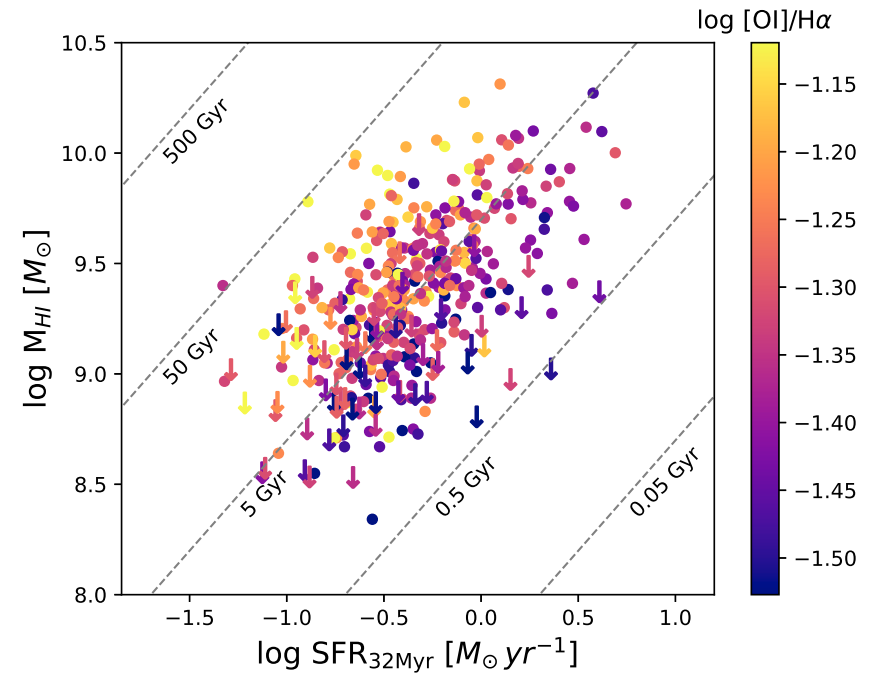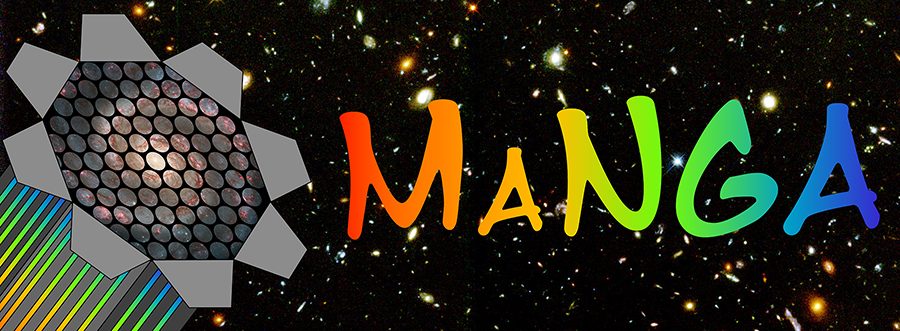Research
My research primarily revolves around the fueling of galaxies, both in terms of what affects their overall gas content, as well as what effects their ability to transform their gas reservoirs into stars. Here are some highlights, but check out my publications page for more details.
The HI-MaNGA Survey

The SDSS-IV MaNGA IFU survey is collecting spatially resolved optical spectroscopic data for more than 10,000 galaxies in the nearby universe. Several of the survey's driving questions revolve around the behavior of cold gas, but the total cold gas content of MaNGA galaxies is generally unknown. HI-MaNGA is a follow-up survey (PI: Karen Masters) using the GBT to measure 21cm emission from all z<0.05 MaNGA galaxies and constrain their neutral atomic hydrogen (HI) content, HI typically being the dominant phase of cold gas in galaxies. I am playing a leading role in this survey, having designed our automated observing script (so we can all sleep at night) and data reduction pipelines. I am also working on using this data set to explore the link between HI content and ISM conditions (Stark et al., 2021, MNRAS, 503, 1345). We show how the link between instantaneous star formation and HI is very weak on short timescales but progressively stronger over longer timescales, highlighting how HI sustains star formation, even if stars do not actively form in HI. We also found that the efficiency with which HI reservoirs are converted into stars is dependent on internal ISM properties, namely the [OI]/Halpha ratio (see figure) and the mean Halpha surface brightness, implying that such galaxies have large amounts of diffuse gas and/or more shock heating.
Using the Radon transform to characterize galaxy velocity fields
IFU and interferometric surveys are (or soon will) give us resolved velocity fields for thousands of galaxies, which means we will really benefit from tools which can quickly and simply characterize these data. I have been exploring how the Radon transform (defined as a series of line integrals through an image at different orientations and offsets from the origin) can be used for this purpose. My collaborators and I have found that the RT is a relatively simple way of determining the mean orientation of a velocity field, and whether it shows signs of non-axisymmetric motions based on whether its kinematic position angle is constant or not. We found that ~2/3 of gas velocity fields, and ~half of stellar velocity fields are inconsistent with uniform circular motion. We find evidence that at least some of the behavior is related to bars, but they cannot explain everything, and we suspect that some of the behavior may also be related to disk warps, tidal interactions, and other internal instabilities (e.g., oval distortions).
Conditions for Star Formation in Galaxies
The physics governing star formation has been a focus of astronomers for decades. We know that star forming regions of galaxy disks tend to be both dynamically unstable and self-shielded from background ionizing radiation, whereas the non/weakly star forming outskirts of galaxies tend to be dynamically stable and not self-shielded. But what defines the transition between these two regimes? Do dynamical instabilities occur first, after which the disk fragments and self-shields, or does self-shielding occur first only after which disk instabilities can form? In Stark et al (2017), we explored this question. With a small sample of nearby galaxies with direct meaurements of gas density, we found that disks become unstable to thermal pressure well before they self-shield. In order to conduct this test for a larger sample of galaxies, we developed a new metric, Qtau, which indicates whether fragmentation or self-shielding is an easier threshold to meet. We calculated this metric for hundreds of galaxies in the MaNGA survey, and found results consistent with gravitational instabilities developing before self-shielding occurs. Our findings with observational data match what is seen in the FIRE simulations (Orr et al. 2017), and highlight the importance of large-scale dynamics in setting the conditions for star formation.
Environmental influences on Galaxy Gas Fractions
 Galaxies are refueled over time through processes like mergers and accretion of the IGM. Galaxies cease forming star when this replenishment is disrupted and they exhaust their gas supply, or if certain processes (e.g., ram pressure stripping) directly remove their gas. I am interested in exploring which of the many possible processes have the biggest impact on galaxy gas content. In Stark et al. 2016, I presented a volume-limited, highly complete census of atomic hydrogen in galaxies in the RESOLVE survey and explored (a) in what size groups/dark matter halos do we start to see signatures of gas deficiency, and (b) is gas content affected by processes acting on scales larger than individual groups? I found signs of gas deficiency in satellites residing in groups similar to the Milky Way, showing that processes which affect gas content are active in even relatively moderate mass groups. Furthermore, gas content appears to depend on the larger-scale density of the cosmic web that groups reside in, suggesting that gas content depends on environmental scales beyond individual dark matter halos. While this work showed where gas deficiency is present, the question remains as to which specific process(es) are driving the observed gas deficiency.
Galaxies are refueled over time through processes like mergers and accretion of the IGM. Galaxies cease forming star when this replenishment is disrupted and they exhaust their gas supply, or if certain processes (e.g., ram pressure stripping) directly remove their gas. I am interested in exploring which of the many possible processes have the biggest impact on galaxy gas content. In Stark et al. 2016, I presented a volume-limited, highly complete census of atomic hydrogen in galaxies in the RESOLVE survey and explored (a) in what size groups/dark matter halos do we start to see signatures of gas deficiency, and (b) is gas content affected by processes acting on scales larger than individual groups? I found signs of gas deficiency in satellites residing in groups similar to the Milky Way, showing that processes which affect gas content are active in even relatively moderate mass groups. Furthermore, gas content appears to depend on the larger-scale density of the cosmic web that groups reside in, suggesting that gas content depends on environmental scales beyond individual dark matter halos. While this work showed where gas deficiency is present, the question remains as to which specific process(es) are driving the observed gas deficiency.
Signatures of gas accretion onto galaxies
Gas accretion is one of those processes which astronomers think is extremely important to galaxy evolution, but is extremely hard to observe directly. In Cheung, Stark, et al. (2016), we studied one unusual example of apparent gas infall in the MaNGA suvey, where a galaxy appeared to be accreting a gas cloud almost as large as the galaxy itself. In addition to individual case studies, I am interested in finding signatures of this process, which can help us identify additional examples and allow us to study gas accretion in a more statistical sense. Using the MaNGA suvey, I am exploring means to identifying gas infall through irregularities in gas velocity fields (Stark et al., in prep).
Atomic to molecular gas transition and widespread formation in Galaxies
 /> Converting gas reservoirs into dense clouds is an important prerequisite to forming stars. Lots of work has explored the local conditions for dense cloud and star formation, but I have explored what larger scale processes can effect galaxies. In Stark et al. (2013), I examined molecular-to-atomic gas ratios of galaxies and found evidence that galaxy interactions are responsible for periodically driving atomic gas inwards where it can turn molecular.
In Stark et al. (submitted), I examined the potential for gas disks to self shield vs. become gravitationally unstable, finding evidence that instability happens well before self-shielding, suggesting this is the more important condition which eventually leads to widespread star formation in galaxies.
/> Converting gas reservoirs into dense clouds is an important prerequisite to forming stars. Lots of work has explored the local conditions for dense cloud and star formation, but I have explored what larger scale processes can effect galaxies. In Stark et al. (2013), I examined molecular-to-atomic gas ratios of galaxies and found evidence that galaxy interactions are responsible for periodically driving atomic gas inwards where it can turn molecular.
In Stark et al. (submitted), I examined the potential for gas disks to self shield vs. become gravitationally unstable, finding evidence that instability happens well before self-shielding, suggesting this is the more important condition which eventually leads to widespread star formation in galaxies.
The Nature of High Velocity Clouds
The Milky Way is surrounded by clouds of gas, typically referred to as "high velocity clouds" (HVCs). HVCs could be tidal debris, ejected gas, satellite galaxies, fresh gas infall, or some combination of all of these, and this is a hotly debated topic. In Stark et al. (2015), I explored the nature of one very massive HVC, the Smith Cloud, and examined whether it could actually be a very gas-rich satellite galaxy. We found no statistical evidence for a stellar population associated with the Smith Cloud, but could not completely rule out the existence of stars. I was a coauthor on Fox et al. (2016) which found the Smith Cloud is actually quite metal-rich (half solar), which is quite inconsistent with the Smith Cloud being a galaxy (or at least, it would be a very unusual one!).



